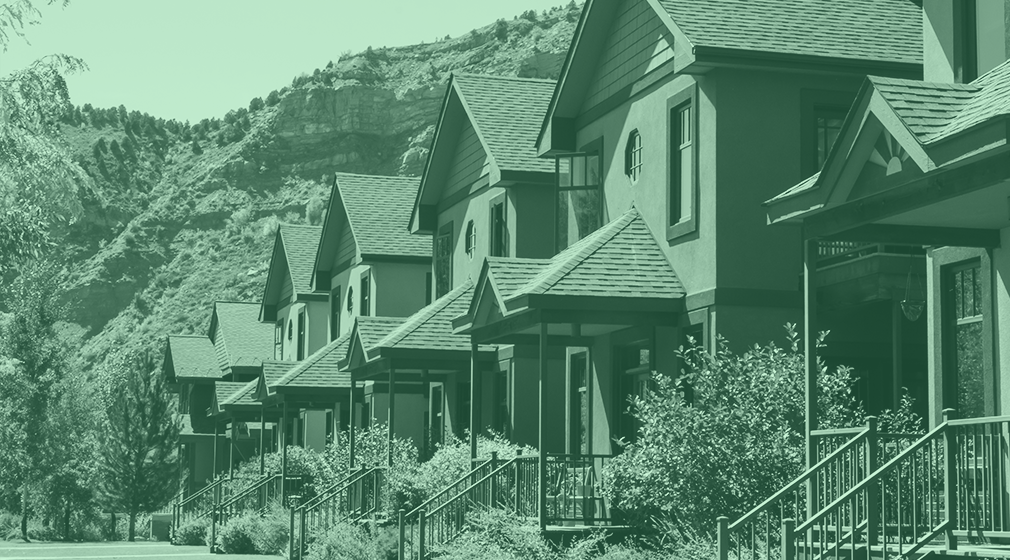How Federal Policies Led to Segregation in the Housing Market

Drive through many metropolitan areas, and you may be able to distinguish unofficial boundary lines that divide neighborhoods—at least in some part—by race. Some might assume that those divisions just happened by chance or preference. But was the segregation of urban areas really as “unofficial” as it might seem today?
In a recent Maxwell Clear to Close podcast, hosts Alan Parris, Bryan Traeger, and Chelsea Mize spoke with Richard Rothstein, author of The Color of Law: A Forgotten History of How Our Government Segregated America. In this eye-opening conversation, Rothstein says that the segregation found in cities across the country has a much more intentional background than most of us realize. Specifically, he points to federal policies implemented in the mid-twentieth century as the root of today’s housing inequalities.
Segregation didn’t happen by accident
The difference in thought begins by understanding two Latin-based legal terms: “de facto” and “de jure.” De facto refers to what happens in practice or in reality, whereas de jure is used to describe what happens through the course of law.
When it comes to discussions about segregation, officials have maintained that neighborhood divisions have occurred de facto—racial separation “just happened” over time. But Rothstein says segregation was de jure—the result of the government explicitly manipulating the free market into the current racially divided reality.
He says, “The residential segregation we have in every metropolitan area of this country was created, sustained, reinforced, and protected by federal, state, and local governments.”
But how could this happen? After all, the Civil Rights Movement created tangible change—no more separate water fountains or separate lunch counters or separate schools. When working toward equality, did the government draw a line at separate neighborhoods?
Well, yes. In some cases there was a literal line drawn.
The dark side of the New Deal
Prior to the Great Depression, America was a nation based on industry, and that industry meant natural urban integration. Factories popped up around city centers based on logistics and convenience; shipping ports and rails dictated location. Those factories needed workers, and workers needed housing close to the factories. Thus, the downtown areas were usually packed with laborers from every nationality. But not for long.
The creation of the New Deal in the 1930s is usually hailed by historians as an economic marvel. But the history books forget that the New Deal wasn’t a good deal for everyone. New Deal programs actually created segregation where it previously didn’t exist. Public housing projects set up by the Public Works Administration were explicitly designated to be for Blacks or for whites. Sounds like a de jure move, doesn’t it?
Then, in the post World War II period, a federal program initiated by the FHA and the VA fostered the move of working class veterans and their families to the suburbs. But the suburbs didn’t really exist yet, especially not for the working class. To remedy this, the government began to back loans for developers who would create inexpensive housing in the suburbs. At the same time, they also subsidized the homeowners who would buy these homes.
Sounds like a great program, right? But here’s the catch: To get this federal backing, developers had to agree not to sell homes to Black buyers and to put a clause in their contracts that the white homeowners would not resell or rent to Blacks in the future. In some areas, developers couldn’t even get government assistance if they were near minority neighborhoods, because of the risk of “infiltration by unharmonious races.”
There was a literal line drawn for who could own which homes.
This is where Rothstein says the government overstepped the Constitution through reinforcing and sustaining discrimination. He points to Levittown, one of the planned suburbs outside of New York, NY, as an example.
“Levitt was a bigot,” Rothstein says. “Left on his own, he would not have sold to African Americans. That’s not in dispute. But he wasn’t left on his own. If the Federal Housing Administration had said to him, ‘We’re not going to guarantee your bank loans unless you sell homes on a non-discriminatory basis,’ bigot or not he would’ve had to do so or not go ahead with his project. And the same is true of all these other developers.”
To learn more about the history of inequality in the housing industry, including redlining practices, read our three part series here:
—The Land of Unequal Opportunity (Pt. 2): How Government Policy Segregated American Neighborhoods
—The Land of Unequal Opportunity (Pt. 3): The Path Towards an Equitable Housing Market
Segregation has far-reaching effects
The government manipulated the market by denying funds based on racial divisions. But it wasn’t only about the housing market. Homeownership forms the foundation of wealth accumulation in America. And wealth accumulation leads to opportunity access in the form of schools, consumables, and even health.
Take those WWII suburban homes as an example. The homes themselves were not extravagant. At about 750 square feet, they sold for around $8,000 at the time, which would be the equivalent of $100,000 in today’s money. White buyers could buy these homes without a downpayment—because they were subsidized by the government—so their initial investment in some cases was literally zero.
As time went on, equity on those houses grew… and grew and grew. Today those same suburban homes are worth $300K to $400K. (In California, it’s more like $700K to $1 million.) With that equity, white families were able to fund education for their children. They had money for unexpected emergencies that would’ve otherwise crippled them financially. They could fund their retirements and bequeath wealth to the next generation.
Thanks to home equity growth, the working class became the middle class. But only for whites.
Today, Black income is about 60% of white income (which is a whole other issue), but the wealth ratio is only 5%. Rothstein says, “That wealth gap determines much of the inequality on the basis of race that we have today. It keeps African Americans in frequently low income, segregated neighborhoods even if they’re middle class, because they have no downpayment—no wealth—to purchase homes outside of those segregated neighborhoods.”
Blacks weren’t just kept out of certain neighborhoods; they were kept from the future opportunities that those neighborhoods afforded their white counterparts.
This systemic inequality has a trickle down effect, of course. Not only does a wealth gap predict school and health disparities; it also informs stereotypes and political polarizations.
Rothstein wonders, “How could we ever expect to develop the common national identity that we need to preserve this democracy if so many African Americans and so many whites live so far from each other?” There’s no chance for shared experiences and natural empathy.
He goes on to say, “People develop stereotypes because of things they see. When they see African Americans living in overcrowded conditions, they come to the conclusion that African Americans are slum dwellers. If those overcrowded conditions were undone by policies, they would see that African Americans were no different than themselves.”
Policies to redress discrimination in housing
Reversing discrimination in housing isn’t as easy as breaking down other forms of segregation, though. Abolishing separate water fountains is easy—one day they’re there, the next day they’re gone. But residential separation is harder to remedy. One day fair housing policies can be instituted, but the next day things look basically the same.
Still, Rothstein believes that if government policies created segregation, it’ll take government policies to make it right. “Capitalism didn’t create this and capitalism can’t uncreate it,” he says. “It was created by government policy that distorted the market. And we need government policies now to redress the damage that was done.”
Though progress is slow-going, some existing policies have taken a baby step in the right direction. The Fair Housing Act helps form a basis for discrimination recourse. But other policies need reform to be effective.
For instance, the Low Income Housing Tax Credit seems to reinforce segregation. It’s easier for developers to build housing projects in low income areas rather than high opportunity areas. The Treasury Department prioritizes the building of affordable housing in historically low income areas, thinking that doing so will make the neighborhoods healthier. Rothstein thinks that’s backwards. Instead, affordable housing units should be put in places of higher opportunity, where minorities can have access to better schools, better supermarkets, and better air quality.
In addition, the Community Reinvestment Act needs reform to really create necessary change. Right now, the only benefit to the borrower is that they can obtain a mortgage — that’s it. The loan originator, on the other hand, gets 30% more revenue which never actually goes to the community. CRA obligations are met by lending to white gentrifiers in the communities, thereby perpetuating the segregated system.
Rothstein says that more effective policies to redress segregation are well known, though to some they seem too radical to implement. What’s missing is a new civil rights movement that will make society and politicians uncomfortable with the status quo in segregated housing. As one example, Rothstein believes that the federal government should be specifically subsidizing African American homebuyers. Racially-specific policies created the problem, so racially-neutral policies are not the answer.
He also suggests that the government should buy those same homes in Levittown and similar suburbs for their current values around $300K-$400K, then resell them to African Americans who only qualify for $100K-$150K loans.
Of course, there are multiple issues at the micro-level that would complicate a scenario like this. Thus, federal policies—while necessary—can only go so far.
Changing the segregated reality
For many Americans, the racially-charged events that occurred in the summer of 2020 have opened up conversations about systemic inequality. Americans are more aware of the apartheidation of our society, and for the most part, they don’t like it. Perhaps that awareness will lead to the change we need at a local level.
Rothstein, a passionate researcher, knows that education is the key to reality change. When asked what sparked his interest in research for The Color of Law, he mentions a school segregation case in Louisville, KY. He’d heard about this case where officials claimed the schools were segregated because the neighborhoods were segregated. They said neighborhoods were split “de facto”, and there was nothing they could do about it. But as he dug into the research, Rothstein found evidence otherwise.
He tells of a case where a middle class, well-decorated Black veteran wanted to purchase a home in the suburbs of Louisville, but no one would sell him one. So a white friend purchased a second home and resold it to this Black friend. After the Black family moved in, an angry mob came to their door, and the police did nothing. In addition, the white friend was arrested and sentenced to jail time for selling to a black man. Rothstein saw nothing “de facto” about this case and others like it. His eyes were opened as he was exposed to truth.
In the same way, education can help to create real change on the local and individual level. “We’ve forgotten about this because the textbooks lie about it,” Rothstein says. Glossing over the true details of the New Deal and the Great Migration helps no one. People need to know truth in order to spark a change in thought that can lead to a change in reality.
And change is happening in some areas. Places like Minneapolis, MN, and Portland, OR, have abolished single family home zoning laws, making it possible for affordable housing to be built in high opportunity areas. Down payment assistance is helping too, though it’s still race-neutral at this time.
As debates about redressing housing segregation continue, the government will need to take the lead, but each individual and company should also take responsibility to be involved in a solution. “The segregation of society is harmful to Blacks and to whites,” Rothstein says. “Of course, it’s much more harmful in so many more ways to African Americans. But this is not a race-specific problem, and there’s no reason why we should expect African Americans to fix it on their own. We have as much responsibility, if not more responsibility.”
Creating housing equality will take a collective effort, and part of that effort involves continuing the conversation about segregation in the housing market.
To learn more about this topic, tune in to Maxwell’s Clear to Close episode with Richard Rothstein, and subscribe to the podcast, where we’ll do our part to continue the quest for change in the housing market.


